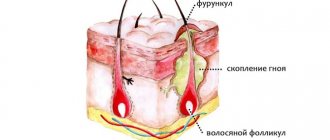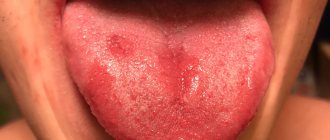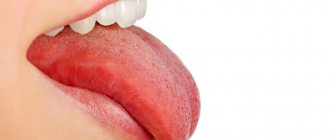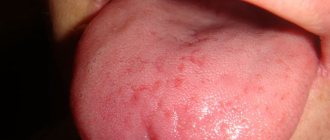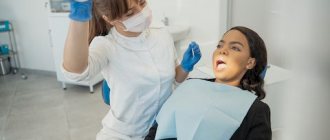To answer the question: why there is a yellow palate in the mouth (see photo), you should study the subject of attention in more detail.
When examining the mouth, in addition to the tongue, gums with teeth and the inner surfaces of the cheeks, a concave dome-shaped surface is also visible, limiting the oral cavity from above.
This palate is a mucous membrane-covered bony structure formed by the palatine processes of the two halves of the upper jaw.
The main purpose of the palate is to be a partition separating the oral cavity from the nasal cavity.
The palate performs the following functions:
- prevents saliva and food from entering the area responsible for breathing and smell recognition;
- ensures unhindered movement of inhaled and exhaled air;
- is responsible for the separate participation of the oral and nasal cavities in the function of sound formation.
In addition to the fixed bone (hard) part of the palate, there is also a soft part. This is a duplication of the mucous membrane (a fold that looks like tissue folded in half), moved up and down by a special muscle: when it contracts, the soft palate rises, and when it relaxes, it lowers.
In a calm state, the soft palate hangs down, allowing free passage of the air stream. But when swallowing, straining and blocking access from behind, from the nasopharynx, it absolutely hermetically separates the two largest cranial cavities from each other, preventing food from entering the nasal space.
Why did the sky turn yellow?
The palate area, like all areas of the skin and mucous membranes on and inside the head, has an abundant blood supply due to a dense network of capillaries.
The palate owes its normal color to the color of the blood flowing through them: in hard ones it is pale pink, in soft ones it is also pink, but of a more saturated dark tone. When inflamed, the color may become flaming crimson or bluish with a purplish tint. If the palate turns red and the throat hurts, this is considered normal, but the palate should not be yellow. For what reason does its color change?
The first thing that comes to mind is smoking. Indeed, the resins contained in tobacco and released when it burns stain the oral mucosa, giving it various shades of yellow and cause the formation of plaque on the palate.
But in addition to direct coloring, smoking:
- causes disorders of blood microcirculation in tissues;
- changes the composition and properties of blood.
Blood cells that contain minimal oxygen become paler, as does the area they supply. At the same time, in the region poorly supplied by them, fatigue and aging of cells increase due to chronic oxygen starvation.
And finally, once the transformations begin, they become irreversible, leading to changes in the biochemistry of tissues and the loss of their original color.
Therefore, the palate in a smoker’s mouth becomes covered with yellow spots with red dots and veins - a picture of capillary paresis.
Reasons why the roof of your mouth may hurt
The upper part of the oral cavity, covered with mucous membrane, is divided into 2 parts - the hard and soft palate. The hard part is the bone wall that separates the oral and nasal cavities. It begins just behind the front teeth and smoothly transitions into the soft fold of mucous membrane near the base of the tongue that separates the oral cavity from the pharynx.
To find out why the roof of your mouth hurts, you should consult a dentist, since there are many prerequisites leading to the appearance of such symptoms. Below are just a few of them:
- People eat hot and hard foods every day, which can burn or scratch areas of the roof of the mouth, both near the front teeth and closer to the throat. And in addition, many people forget about basic hygiene rules, as a result of which harmful microorganisms develop in the oral cavity - and the mucous membrane covering it becomes inflamed. It should be remembered that even a small wound is susceptible to infection.
The photo shows an inflamed sky
The cause of pain in the palate and the appearance of a white coating on it can be a fungal infection. The most common causative agent of oral inflammation is Candida fungus, which can affect not only the inside of the mouth, but also the lips. Candidiasis or fungal stomatitis often occurs in girls and infants.
- The palate can become inflamed when the herpes virus is activated. This disease manifests itself not only externally (on and around the lips), but also inside the mouth. Patients feel itching in the affected area, and sometimes their body temperature rises.
- With the development of tonsillitis, a sharp enlargement of the tonsils is observed, accompanied by their redness. Sometimes with this disease, the upper palate becomes inflamed and swollen, turning a bright red hue.
- Don’t forget about one of the most common diseases of children and adults – caries. It usually affects only the teeth, but the infection can spread to the surrounding soft tissue.
- Inflammation of the palatal tissues may indicate the formation of a benign tumor, so it is important to constantly monitor your condition.
- If the soft tissues of the tongue and palate on top are swollen and covered with whitish spots, it is worth checking for the presence of leukoplakia. This disease develops in those who often eat hot food, come into contact with chemicals, as well as in people with improperly installed dentures or chipped teeth.
- The cause of inflammation of the palate is often the passage of procedures using galvanic current - when installing braces, crowns, and during some types of dental treatment.
- Redness, swelling and irritation of the gums and other soft tissues inside the mouth in adults can be caused by smoking and drinking alcohol.
Signs of inflammation of the palate in the mouth are varied and depend on the cause of its development, so self-diagnosis in this case is difficult. That is why it is necessary to contact a specialist with this problem as quickly as possible to make an accurate diagnosis and prescribe a course of treatment.
Sometimes areas of the soft palate closer to the throat swell due to allergies to medications. If pain is felt while taking medication, you should stop treatment and consult a doctor. If the soft tissue swells too quickly, an antihistamine should be taken.
What diseases can there be?
In addition to smoking, the following diseases can cause a yellow palate in the mouth:
- liver;
- kidney;
- gastrointestinal organs.
Or lipid metabolism disorders lead to the same result.
Liver diseases
Disorders of intrahepatic metabolism lead to profound disorders in the biochemistry of all organs and systems of the body and disorders of all types of metabolism:
- protein;
- fat (lipid);
- carbohydrate;
- microelement;
- pigmented.
There is a disruption in the formation of vitamins and hormones, blood parameters change (viscosity, etc.), which leads to tissue hypoxia, which is fraught with biochemical changes on a local scale. In relation to the upper soft and hard palate, this can be either pallor and loosening of the mucous membrane, or a change in its color to yellow.
In case of liver diseases, the appearance of the palate will be particularly diverse, namely:
- yellowish corners of the anterior part of the soft palate with lines in the middle are characteristic of chronic cholecystitis and gallstones;
- Liver cirrhosis is characterized by the appearance of yellow spots in areas of dying tissue;
- viral hepatitis in the icteric phase also leads to staining of the palate.
Kidney diseases
Kidney diseases threaten the body not only with edema and dangerous blood thinning due to impaired water excretion, but also with the accumulation of many toxic substances in the blood: uric acid, creatinine, heavy metal salts and others, which also affect the biochemistry and color of tissues.
Diseases of the gastrointestinal tract
A change in the properties of the digestive juice, bile, which has a pronounced yellow color, during inflammation, which occurs in parallel in the liver and pancreas, leads to the deposition of bile salts in the tissues of the skin and mucous membranes. The skin responds to this process not only with itching, but also with a change in color. The same is observed in the mucous membranes lining various cavities.
With pathology characteristic of the liver-pancreas system, a bronze-icteric color appears exclusively on the soft palate.
The palate may turn yellow due to chronic inflammation in the small and large intestines with frequent constipation.
Blood diseases rarely have an independent character; most often they are a reaction to metabolic disorders in the liver or other organ systems. But its properties determine not only the level of tissue chemistry, but also their color.
It is for this reason that the skin of patients not only due to liver diseases (malaria, hepatitis), but also due to anemia-anemia, looks icteric, as well as the mucous membranes. In addition, the phenomenon of hemolysis is inherent in blood, and the transition of the initial “bruises” to yellow is a common thing for hemoglobin.
A yellow color to the body can also be given by “bronze disease” - a pathology of the adrenal glands, also called Addison’s disease.
Gastrointestinal diseases
The causes of a yellow soft palate in the mouth may be associated with gastrointestinal diseases. Changes in the properties of digestive juice during inflammation cause the deposition of bile salts in the tissues of the skin and mucous membranes. Sometimes itching appears on the skin, and a change in color is observed. The same symptoms also appear on the mucous membranes lining various cavities.
The yellow palate of the mouth may be due to chronic inflammation in the small and large intestines with frequent constipation. With pathologies in the liver and pancreas, a bronze-icteric color appears on the soft palate.
Blood diseases rarely manifest themselves; they are usually a reaction to metabolic disorders in the liver or other organ systems. Why is the palate in my mouth yellow? This may be due to anemia and anemia. Also, yellow color may indicate pathology of the adrenal glands.
Associated symptoms
In addition to staining the palate yellow, the diseases that cause it also have other characteristic accompanying symptoms. So, this is when:
- kidney pathologies - swelling and urinary disorders;
- blood diseases - symptoms of insufficient blood supply to organs (up to the development of trophic disorders or enlarged lymph nodes);
- changes in the liver - digestive disorders and all types of metabolism.
But if, with diseases of the digestive system, metabolism also suffers and body weight changes, then Addison's disease is characterized by crises. Caused by acute adrenal and vascular insufficiency, they are expressed:
- sudden sharp pain in the lower back, legs, abdomen;
- a sharp decrease in the ability to move (adynamia);
- severe (hectic) fever;
- intense diarrhea and vomiting, quickly leading to dehydration and shock;
- sharply developing arterial hypotension (drop in blood pressure);
- loss of consciousness occurring after a previous short acute psychosis with confusion or delirium;
- violation of water-salt metabolism due to low levels of adrenal hormones in the blood, detected by laboratory tests.
Considering the formation (due to hemolysis) of brown plaque on the teeth and tongue, there is a very high probability that the first doctor a patient with “bronze disease” will visit will be a dentist.
Diagnostic methods
You should begin studying the problem with a visit to the dental office, because only a dentist is able to conduct the most complete and competent examination of the oral cavity.
When treating a patient, the dentist will pay attention not only to the palate - he will examine and examine the entire oral cavity, including the spaces between the cheeks, gums, and lips and the area under the tongue.
Because it is in these hidden places that something that does not catch the eye at a quick glance can be discovered, for example, the first signs of thrush-candidiasis.
Considering that pigmentation of the palate is rarely an independent condition, in addition to a dental examination, the help of other medical specialists may be required to diagnose the problem:
- therapist;
- ENT doctor;
- oncologist;
- allergist.
A mandatory part of diagnosis is laboratory studies of the internal environment of the body in the form of biological fluids: blood, urine, bile, and feces.
It may be necessary to perform allergy tests and study the body’s immune system using instrumental (ultrasound, MRI, CT, radiography) and laboratory methods.
Yellow palate in the mouth of an adult
If the sky has turned yellow, you should see a dentist. During the examination, the specialist will determine whether the yellowness of the mucous membrane is a sign of any disease, or indicates a lack of proper oral hygiene.
The patient’s attitude towards bad habits is also taken into account. Yellowness with a pronounced network of veins is often formed as a result of regular smoking.
When conducting diagnostics, the patient's age is taken into account. In people over 50 years of age, the appearance of yellow plaque on the palate is considered a physiological process, so serious health problems are not always detected.
Read also: People are awesome translation
The child has
A yellowed sky appears not only in adults, but also in children. In addition to dental problems, this sign may indicate other diseases, so the child should be shown to a gastroenterologist, ENT specialist, pediatrician, infectious disease specialist, or hepatologist.
Often, young patients with this symptom are diagnosed with thrush. If there is any doubt in determining the problem, it is recommended to undergo a full examination, including donating blood to check bilirubin levels.
Treatment methods
The data obtained after completing all the necessary studies provides an answer to the question: what is the patient dealing with?
If a therapeutic pathology is detected (diseases of the gastrointestinal tract, kidneys, etc.), treatment is carried out by a general practitioner or a specialist with a narrower profile:
- gastroenterologist;
- urologist:
- nephrologist.
In the case where there is a systemic disease of the category rheumatism, syphilis, HIV, treatment is necessary in a specialized medical institution.
The presence of oncological pathology may require joint treatment by an oncologist, a surgeon and consultant doctors of various profiles: a neurologist, an ophthalmologist and others.
If there is a local microbial-viral nature of the lesion in the oral cavity, antiseptics and antibiotics recommended by the dentist can be used.
After the process subsides or during it, professional cleaning of the oral cavity is often required, without which one cannot count on the success of treatment. It may be necessary to repair or replace existing orthodontic structures in the mouth.
Personal hygiene should be ensured by the patient himself, who is interested in resolving the problem as quickly as possible.
Features of treatment
Treatment involves not only restoring the normal color of the sky, but also eliminating the main cause that led to the deviation. For yellowing of the palate and a bitter taste in the mouth, if this is associated with liver disease, herbal remedies are prescribed. These are “Gepabene”, “Hofitol”, “Silymarin”. Regenerating agents are also accepted - “Essentiale”, “Phosphogliv”, and preparations of animal origin - “Hepatosan”.
For kidney diseases, complex treatment is prescribed. Diuretics are prescribed - Furosemide, Veroshpiron. They also use antispasmodics - “Papaverine”, “No-shpa”, herbal medicines - “Canephron”, “Cyston”, drugs for lowering blood pressure - “Pentamine”, Reserpine.”
Therapy for gastrointestinal diseases is determined by the specific ailment. For example, for bacterial gastritis, antibiotics are used - Levomycetin, Tetracycline. The antibiotic Amoxicillin is effective for ulcers. To eliminate pain, antispasmodics – “Platifillin” – are used. Pepsin is used to stimulate the secretory function of the stomach. In addition to treating the underlying disease, symptomatic therapy is needed. The patient must use antiseptics. You should also rinse your mouth with a decoction of sage or chamomile, and perform salt baths (1 teaspoon of salt per 1 tablespoon of boiling water).
Treatment with traditional methods
The general principles of treatment with traditional methods do not differ from those in medicine and dentistry:
- the use of antiseptics (teas, infusions) for oral hygiene;
- increasing the level of health with the help of traditional, proven means (honey and bee products and the like).
The use of traditional medicine methods should in no way contradict the requirements of official science; proposals to use unstudied or questionable treatment methods should be categorically rejected.
The use of any form of rinse or other treatment method must be approved by the patient's attending physician.
Folk remedies
Treatment with traditional methods is no different from those offered by medicine and dentistry. Home therapy involves:
- The use of antiseptics to be used in oral hygiene. These can be teas and infusions.
- Promoting health using traditional means. Honey and bee products are used for this.
Traditional medicine methods can only be used after consultation with a doctor. Also, do not use dubious means. Only then will the treatment bring positive results.
Prevention measures
Preventive measures include the following:
- careful and attentive care of teeth and oral cavity in general;
- visiting the dentist in a timely manner and following his recommendations, and if problems arise, providing professional assistance;
- preventing possible diseases by fully increasing the body’s defenses (maintaining a consciously healthy lifestyle), and in the event of an acute pathology, its timely treatment.
As a conclusion from what has been said: a person needs to be constantly engaged in maintaining health, but if problems arise, be sure to consult a specialist doctor.






